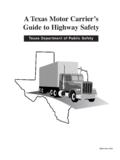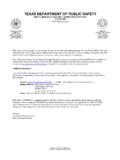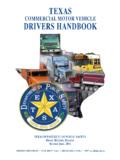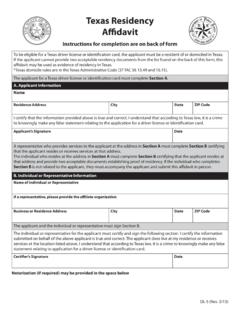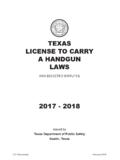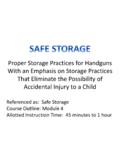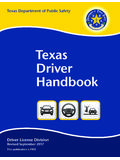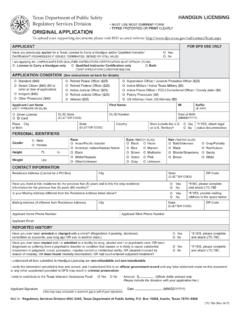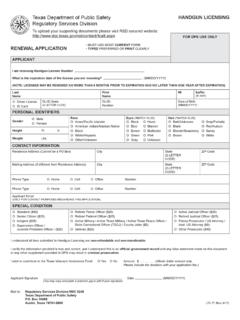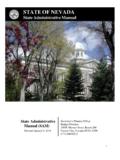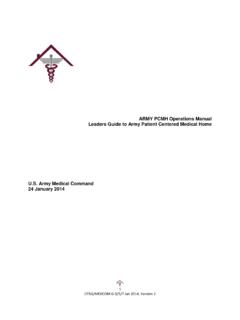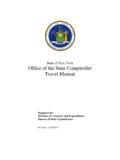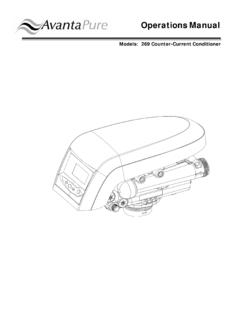Transcription of Vehicle inspection operations & training Manual …
1 Vehicle inspection operations & training Manual for official Vehicle inspection stations( Vehicle eMissions inspection )This Manual presented by:DPS Representative Street City Phone RSD-87A (04/2017)TABLEOFCONTENTSCHAPTER 1 INTRODUCTIONCHAPTER 2 ACCELERATIONSIMULATIONMODE2(ASM2)CHAPTER 3ON-BOARDDIAGNOSTICSII(OBDII)INSPECTIONC HAPTER 4 TWO-SPEEDIDLE(TSI)INSPECTIONPROCEDURE(EL PASO,TRAVIS,&WILLIAMSONCOUNTIESONLY)CHAP TER 5 REFERENCESECTIONCHAPTER ONE INTRODUCTION INTRODUCTION I/M PROGRAMS OVERVIEW Purpose Objective Goal I/M PROGRAM DESIGN I/M PROGRAM APPLICABILITY LAYOUT OF Manual PUBLICATION AUTHORITY OBLIGATION TO ADHERE TO Manual INTRODUCTION This Manual provides the Department s instruction to inspection stations and inspectors for conducting the Vehicle emissions inspection in counties with Vehicle emissions inspection and maintenance (I/M) programs.
2 This Manual supplements the Vehicle inspection operations & training Manual , which provides instructions for the annual safety inspection in those counties. PROGRAM OVERVIEW Purpose The purpose of the state s I/M program is to ensure compliance with the requirements of the Federal Clean Air Act, Environmental Protection Agency (EPA) regulations, the Texas Clean Air Act, and the State Implementation Plan regarding Vehicle emissions in affected counties. Objective The objective of the I/M program is the reduction of air pollution from motor vehicles by means of various emissions inspections to determine compliance with established emissions standards, and to ensure that necessary repairs are completed. Goal The goal of the I/M program is for the State of Texas to meet the National Ambient Air Quality Standard (NAAQS). I/M PROGRAM DESIGN The design of the I/M program is to concentrate on specific pollutants found in Vehicle exhaust emissions.
3 Those pollutants are carbon monoxide (CO), hydrocarbons (HC), and nitrogen oxides (NOx). The Texas I/M Program is similar to programs utilized in counties across the having air quality below the National Ambient Air Quality Standard. Carbon monoxide is a colorless, odorless, and tasteless gas sometimes found in urban areas in concentrations that can be harmful to people. It is a by-product of combustion and the automobile is the single largest source of this pollutant. Hydrocarbons are organic compounds composed of hydrogen and carbon. The energy in such compounds is released when combined with oxygen during combustion. Most engine fuels, such as gasoline, propane, methane, etc., contain hydrocarbons and some portion remains after combustion. Hydrocarbons and nitrogen oxides react with sunlight and warm temperatures to form ground-level ozone. Ground-level ozone, a main ingredient in smog, can cause upper respiratory problems and lung damage.
4 Nitrogen oxides, or NOx, is the generic term for a group of highly reactive gases, all of which contain nitrogen and oxygen in varying amounts. Many of the nitrogen oxides are colorless and odorless. However, one common pollutant, nitrogen dioxide (NO2), along with particles in the air, is often seen as a reddish-brown haze (smog) over many urban areas. During combustion, high heat and pressure will cause nitrogen to combine with unused oxygen. 1 The specific Vehicle emissions test used in the I/M program area and in specific counties focuses on the pollutant problem for that area. I/M PROGRAM APPLICABILITY The I/M program is applicable in all affected counties. The term "affected counties" applies to all counties classified as nonattainment, where the State Implementation Plan (SIP) requires an I/M program and participating counties that voluntarily enter the program in an effort to avoid classification as non-attainment.
5 In this Manual , the affected counties are located in the following areas: Dallas/Ft Worth area (Collin, Dallas, Denton, Ellis, Johnson, Kaufman, Parker, Rockwall, and Tarrant counties), Houston/Galveston area (Brazoria, Fort Bend, Galveston, Harris, & Montgomery counties), El Paso area (El Paso County), and the Austin area (Travis and Williamson counties). In El Paso, Travis and Williamson counties, the I/M program focuses on the reduction of carbon monoxide and hydrocarbon emissions. In all other affected counties, the focus is the reduction of carbon monoxide, hydrocarbon, and oxides of nitrogen emissions from designated vehicles. LAYOUT OF Manual This Manual consists of five (5) chapters. Chapter 1 is an introductory chapter, which explains the purpose and goals of the program. Chapter 2 describes the Acceleration Simulation Mode 2 (ASM2) emissions test performed on 1995 and older designated gasoline powered vehicles in all affected counties except El Paso, Travis and Williamson counties.
6 Chapter 3 describes the On-Board Diagnostic Second Generation (OBDII) emissions test performed on 1996 and newer designated gasoline powered vehicles in all affected counties. Chapter 4 describes the Two Speed Idle Test (TSI), which is the type of emissions test performed on all 1995 model year and older designated vehicles in El Paso, Travis and Williamson counties. Chapter 5 is a reference section. Additionally, Chapter 5 contains DPS Administrative Rules 37 TAC ( Vehicle Emissions inspection and Maintenance Program). PUBLICATION AUTHORITY This Manual is promulgated under the authority of the Texas Transportation Code, Chapter 548, the Texas Health and Safety Code, Chapter 382 (Texas Clean Air Act), and administrative rules adopted by the Department of Public Safety. OBLIGATION TO ADHERE TO Manual Failure to comply with any law, rule, regulation, or provision of this Manual pertaining to Vehicle emissions inspection will result in adverse administrative action that may result in the denial, suspension, or revocation of your inspection authority, and/or criminal charges when applicable.
7 2 CHAPTER TWO ACCELERATION SIMULATION MODE 2 (ASM2) inspection PROCEDURE *THIS CHAPTER IS NOT APPLICABLE IN El PASO, TRAVIS & WILLIAMSON COUNTIES CHAPTER TWO ACCELERATION SIMULATION MODE 2 (ASM2) inspection PROCEDURE ACCELERATION SIMULATION MODE 2 (ASM2) EMISSIONS inspection GENERAL ASM2 TEST PROTOCOL STATION REQUIREMENTS FOR ASM2 TESTING TESTING DATA COLLECTION CERTIFIED INSPECTORS ASM2 TESTING APPLICABILITY INSPECTIONS ASM2 inspection DETAILS FEES REPORTS ANALYZER LOCKOUTS APPROVED EQUIPMENT ACCELERATION SIMULATION MODE 2 (ASM2) EMISSIONS inspection GENERAL The primary Vehicle emissions analyzer certified by the Texas Commission on Environmental Quality (TCEQ) is capable of performing all emissions tests required by the Texas I/M program. The tests are the Acceleration Simulation Mode 2 (ASM2), On-Board Diagnostic II (OBDII), and Two-Speed Idle (TSI).
8 The analyzer software is designed to administer the required emissions test. This analyzer must be used for inspections in all affected counties except those stations with an OBD-only waiver. This chapter describes the procedures used by certified inspectors in conducting the Acceleration Simulation Mode 2 (ASM2) emissions inspection on designated vehicles in affected counties. ASM2 TEST PROTOCOL The Acceleration Simulation Mode 2 (ASM2) is a loaded-mode emissions test using a five-gas analyzer and dynamometer (a treadmill-like device for the front or rear traction tires of the Vehicle ). It measures exhaust emissions for levels of hydrocarbon, carbon monoxide, and nitrogen oxides. This I/M program uses an ASM test with two modes, hence the use of 2 as a suffix. In the 50/15 mode, the Vehicle is tested on the dynamometer simulating the use of 50% of the Vehicle available horsepower to accelerate at a rate of miles per hour (mph) per second to a constant speed of 15 mph.
9 In the 25/25 mode, the Vehicle is tested on the dynamometer simulating the use of 25% of the Vehicle available horsepower to accelerate at a rate of mph per second to a constant speed of 25 mph. In this Manual , the term ASM shall refer to the Acceleration Simulation Mode 2 (ASM2) test. STATION REQUIREMENTS FOR ASM TESTING In addition to all equipment required to perform safety inspections, all inspection stations performing Acceleration Simulation Mode (ASM) emissions testing must also have a minimum of the following: 1. A five-gas analyzer and dynamometer with gas cap tester certified by Texas Commission on Environmental Quality (TCEQ). 2. Approved Bar 97 High and Low calibration gas for the analyzer. 3. A designated telephone line dedicated solely to each analyzer in the program (Internet connection recommended). 4. An engine cooling fan provided by the analyzer manufacturer or a replacement fan meeting the original equipment specifications; maximum outside diameter of 30 inches, and a minimum cubic feet per minute (CFM) rating of 3000 CFM.
10 5. An adequate supply of printer supplies. 6. All required analyzer manuals. 7. A business arrangement with the Texas Information Management Systems (TIMS) contractor to obtain a telecommunications link to the Vehicle Information Database (VID). If the inspection station fails to pay its data link fees to the contractor, then the analyzer will be locked out from any further inspections until the problem is resolved. TESTING DATA COLLECTION All certified emissions inspection stations must report the results of emissions testing, since the collection and reporting of accurate Vehicle emissions testing data has significant importance for the inspection and Maintenance (I/M) program. Each analyzer is allowed a certain number of off-line inspections since occasional telephone line problems may occur. After restoration of the telephone link, the off-line data will be sent to the VID. However, when the analyzer exceeds the off-line inspection limit the analyzer will be locked out from any further inspections until the problem is resolved.
